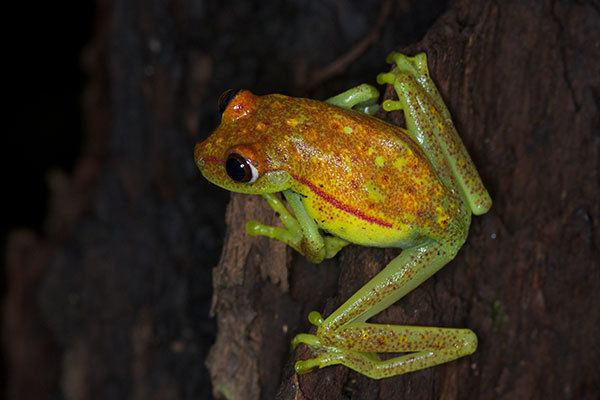Order Anura Genus Hypsiboas Higher classification Hypsiboas | Phylum Chordata Scientific name Hypsiboas punctatus Rank Species | |
 | ||
Similar Frog, Amphibians, Hypsiboas, Excidobates, Marañón poison frog | ||
The polka-dot tree frog (Hypsiboas punctatus) is a frog species in the family Hylidae found in Argentina, Bolivia, Brazil, Colombia, Ecuador, French Guiana, Guyana, Paraguay, Peru, Suriname, Trinidad and Tobago, and Venezuela. In Spanish, it is known as rana punteada ("dotted frog").
Its natural habitats are subtropical or tropical dry forests, subtropical or tropical moist lowland forests, subtropical or tropical swamps, subtropical or tropical moist montane forests, swamps, freshwater marshes, intermittent freshwater marshes, rural gardens, urban areas, and heavily degraded former forests. It is not considered threatened by the IUCN.
Pigmentation and skin fluorescence
A frog collected in the Santa Fe Province in Argentina by Taboada et al (2017) is the first terrestrial amphibian, amongst 5,000 species of frog, identified as naturally fluorescent.
When exposed to ultra-violet light, the skin of the tree frog emits a bright green fluorescent glow. The discovery was made accidentally when the researchers checked the skin secretions of the frog under UV light. They expected only a faint red fluorescence, because the frog skin contains biliverdin, a green tetrapyrrolic bile pigment responsible for its dull mottled browny-green colour. The surprising green fluorescence is attributed to hyloin compounds, mainly hyloin-L1, hyloin-L2 and hyloin-G1. These fluorescent molecules, in the dihydroisoquinolinone family and derived from the isoquinoline (a benzene ring fused to a pyridine ring), in an alkaloid protecting mucous membrane, have been identified in the lymph tissue, skin and glandular secretions of the frog.
According to Taboada and colleagues the fluorescence intensity represents about 18−29% of the luminosity under twilight conditions and is suspected to play a possible role in the communication, camouflage and mating of the frog.
